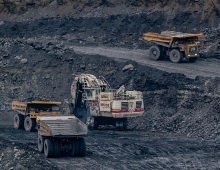Michelle Galloway
Sonwabile Mnwana of the Department of Sociology and Anthropology at the University of Fort Hare spoke at the The Stellenbosch Institute for Advanced Study about his research into how the South African mining industry has excluded the black population and led to land dispossession and poverty. In his research he looks at who the recognised authorities are in rural areas on the platinum belt, the role of customary law in the former homelands and how history has shaped political structures and power over underground resources.
According to Mnwana, the benefits of mining for local communities on the platinum belt and the rural poor are minimal and often those who are customary land rights holders have no say over mining and other developments due to political structures that are still largely based on colonial and apartheid rule. His research, which he has been conducting for the past decade, explores the struggles of ordinary people in the platinum-rich areas in South Africa’s North West province.
“South Africa’s post-apartheid state, despite nationalising all mineral resources, has failed to ensure that the benefits of mining accrue to the historically excluded black population and to local communities where the industry’s operations occur,” he says.
Mnwana says the rapid expansion of mining into the former homeland areas over the past two decades, has produced new struggles in rural South Africa and land that was once used as farmland is either being assessed for new mining sites, or turning into mine dumps.
“The dwindling of gold meant that platinum mining has expanded and risen in value – it’s the biggest mining frontier. What is unique about this area is that most of these mining projects are on communal land under tribal chiefs – land that used to fall under the former homeland,” he says.
But the struggle for land on the platinum belt has a long history. When the Dutch settlers arrived in the 1800s they encountered a dry terrain and small, very spread out groups of mostly Tswana people who were easily defeated by settlers with guns. Land was demarcated into farms and parcelled off to white owners.
“By the late 1880s many Africans were living on white-owned farms as tenants and sharecroppers,” says Mnwana. Although some did enter the colonial land market as owners, it was usually via white intermediaries and at great risk of losing their purchase. These land purchases had to be registered with a chief and the buying process was difficult because many were illiterate and had to depend on missionaries and the like to fill out and process their documentation. Swindling was not uncommon, state officials were not sympathetic to African buyers and the purchases often took years.
“Mineral rights were also separated from surface rights. So mineral rights were not sold to Africans in most cases,” says Mnwana.
“Quite often, these were distinct land-buying syndicates of farmers – not ethnically or culturally homogeneous. At times, they didn’t even necessarily speak the same language but were forced to be part of a tribal unit to register land often under a state-appointed chief. This made the tribal authorities more powerful,” says Mnwana.
The 1913 Land Act and legalised segregation of the 1950s meant that African institutions of property holding were further ignored and the focus on chiefs was strengthened. All of this was further complicated with the expansion of platinum mining from the 1960s. Mineral rights, where held, were held under state custodianship, land was fenced off and often the chiefs received the royalties.
“Resistance to the chiefs’ abuse of power goes back to the 1950s,” says Mnwana. “Royalties were paid into the so-called development account of the tribe which were kept by the homeland government on behalf of the traditional authority.”
From the early 2000s, the ANC government was determined to nationalise minerals and introduce state custodianship. They encouraged communities receiving royalties to convert them into shares and equity which meant they didn’t get money directly. Although in some cases, chiefs remained wealthy.
“Many people feel that nationalisation of minerals left the communities that own the land empty handed. At the point where royalties could have benefitted them, the state took them away, leading to the emergence of more radical exclusive demands. This has led to significant struggles in which people have died as well as lengthy court battles,” he says.
“Ordinary villagers make radical demands – for direct cash payments – that are rooted in private group ‘ownership’ of land and mineral resources,” says Mnwana. “Most of these struggles take the form of custom where claimants articulate claims based on customary law and land rights. But we encounter different versions of culture and history depending on which group claims.”
Customary law is not a new phenomenon but has its own dynamics in South Africa. Customary law, to some extent, has been distorted and used to crystallise power in the hands of traditional authorities, says Mnwana, who is also interested in understanding the socio-economic aspects in more detail.
“Mining is supposed to be a development enterprise but people are being dispossessed. Mining has created a massive surplus, unemployed population in the platinum belt. There is a strong sentiment that mine work is dangerous and not for them and many young people are moving to bigger cities,” he says.
The role of the mining industry at a local level has so far received limited empirical focus, which is ironic because mining positions itself as an agent of local development through its social corporate investment programmes, says Mnwana. There has also not been a detailed focus on how the poor themselves imagine distribution and development and many studies limit the voice of the poor. Mnwana’s study seeks to contribute towards addressing this impasse by a detailed analysis of the rural-based platinum industry.
“History, custom and law have become tools of exclusion in the contest of conflict in South Africa’s rural mining frontier,” says Mnwana. “In the context of mining-led local conflict, custom and law are not only contested notions and spaces, but also instruments of power and contestation.”










